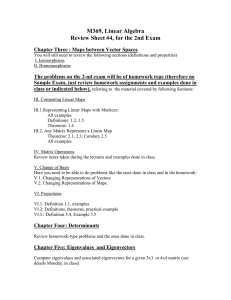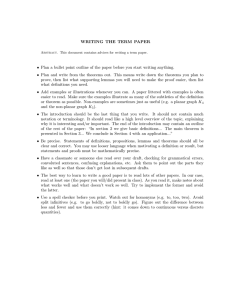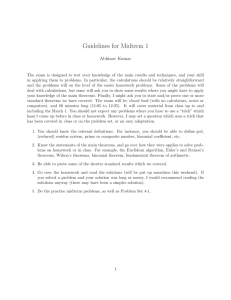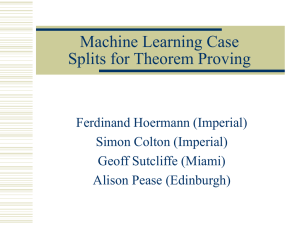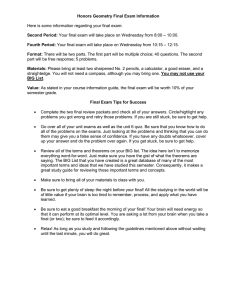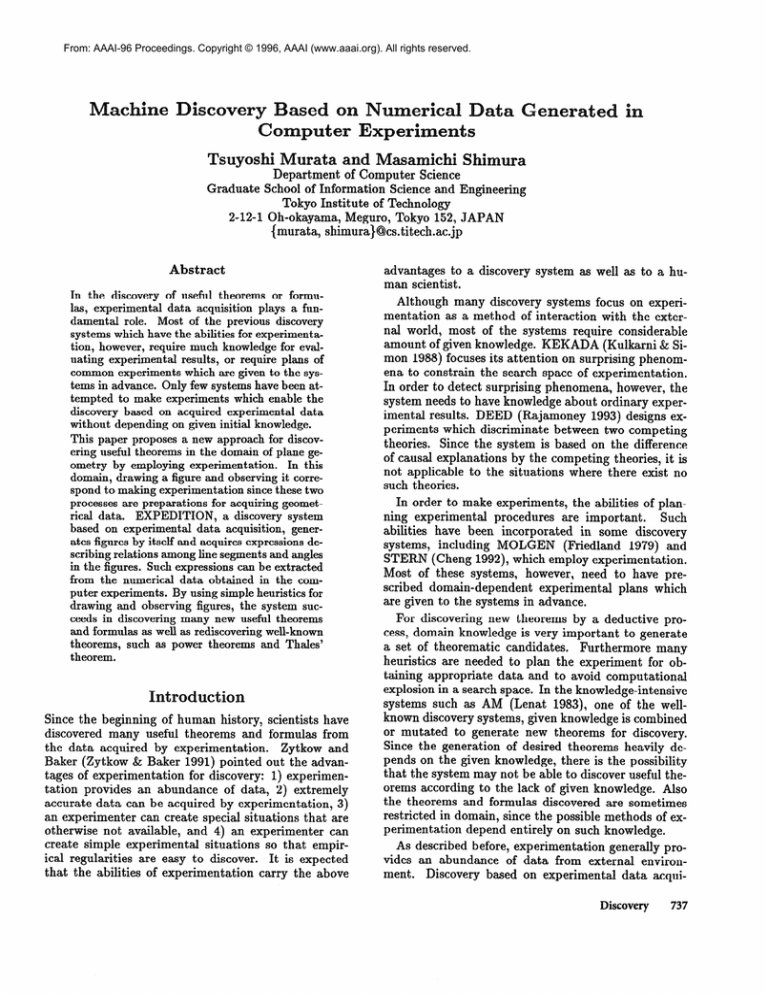
From: AAAI-96 Proceedings. Copyright © 1996, AAAI (www.aaai.org). All rights reserved.
era
ine
Tsuyoshi Murata and
asamichi Shimura
Department of Computer Science
Graduate School of Information Science and Engineering
Tokyo Institute of Technology
2-12-1 Oh-okayama, Meguro, Tokyo 152, JAPAN
{murata, shimura)@cs.titech.ac.jp
Abstract
In the discovery of useful theorems or formulas, experimental data acquisition plays a fundamental role. Most of the previous discovery
systems which have the abilities for experimentation, however, require much knowledge for evaluating experimental results, or require plans of
common experiments which are given to the systems in advance. Only few systems have been attempted to make experiments which enable the
discovery based on acquired experimental data
without depending on given initial knowledge.
This paper proposes a new approach for discovering useful theorems in the domain of plane geometry by employing experimentation.
In this
domain, drawing a figure and observing it correspond to making experimentation since these two
processes are preparations for acquiring geometrical data.
EXPEDITION,
a discovery system
based on experimental data acquisition, generates figures by itself and acquires expressions describing relations among line segments and angles
in the figures. Such expressions can be extracted
from the numerical data obtained in the computer experiments. By using simple heuristics for
drawing and observing figures, the system succeeds in discovering many new useful theorems
and formulas as well as rediscovering well-known
theorems, such as power theorems and Thales’
theorem.
Introduction
Since the beginning of human history, scientists have
discovered many useful theorems and formulas from
the data acquired by experimentation.
Zytkow and
Baker (Zytkow & Baker 1991) pointed out the advantages of experimentation for discovery: 1) experimentation provides an abundance of data, 2) extremely
accurate data can be acquired by experimentation, 3)
an experimenter can create special situations that are
otherwise not available, and 4) an experimenter can
create simple experimental situations so that empirical regularities are easy to discover. It is expected
that the abilities of experimentation carry the above
advantages to a discovery system as well as to a human scientist.
Although many discovery systems focus on experimentation as a method of interaction with the external world, most of the systems require considerable
amount of given knowledge. KEKADA (Kulkarni & Simon 1988) focuses its attention on surprising phenomena to constrain the search space of experimentation.
In order to detect surprising phenomena, however, the
system needs to have knowledge about ordinary experimental results. DEED (Rajamoney 1993) designs experiments which discriminate between two competing
theories. Since the system is based on the difference
of causal explanations by the competing theories, it is
not applicable to the situations where there exist no
such theories.
In order to make experiments, the abilities of planning experimental procedures are important.
Such
abilities have been incorporated in some discovery
systems, including MOLGEN (Friedland 1979) and
STERN (Cheng 1992), which employ experimentation.
Most of these systems, however, need to have prescribed domain-dependent experimental plans which
are given to the systems in advance.
For discovering new theorems by a deductive process, domain knowledge is very important to generate
a set of theorematic candidates. Furthermore many
heuristics are needed to plan the experiment for obtaining appropriate data and to avoid computational
explosion in a search space. In the knowledge-intensive
systems such as AM (Lenat 1983), one of the wellknown discovery systems, given knowledge is combined
or mutated to generate new theorems for discovery.
Since the generation of desired theorems heavily depends on the given knowledge, there is the possibility
that the system may not be able to discover useful theorems according to the lack of given knowledge. Also
the theorems and formulas discovered are sometimes
restricted in domain, since the possible methods of experimentation depend entirely on such knowledge.
As described before, experimentation generally provides an abundance of data from external environment. Discovery based on experimental data acquiDiscovery
737
sition, therefore, is more desirable for a discovery system. This is because the method is expected to make
up for missing initial knowledge by discovering knowledge from observed experimental data. Especially in
the domain of plane geometry, much data from which
useful theorems are extracted can be obtained by drawing figures and by finding their geometrical relations.
As Shrager and Langley (Shrager & Langley 1990)
pointed out, a discovery system for mathematics is unusual compared with a system for physics or chemistry,
in that the system can generate data internally rather
than observing them in a real or simulated environment. This means that a discovery system for mathematics has the property of making internal experiments
with less knowledge of experimentation than the systems for other domains. A discovery system for plane
geometry, which is our target, is also able to take the
advantage of the property by generating figures and
observing them in the system.
This paper proposes a new approach for discovering useful theorems in the domain of plane geometry
by employing experimentation. EXPEDITION, a discovery system based on EXPErimental Data acquisITION, generates figures automatically by drawing lines
one by one, and observes the figures in order to extract numerical data. From the numerical data, expressions about line segments and angles are acquired.
Although many expressions are acquired from a figure,
the expressions about line segments and angles which
are newly generated by the last additional line are regarded as useful in the system since the expressions
cannot be acquired from the figure before drawing the
line. With only two simple heuristics for drawing and
observing figures, EXPEDITION succeeds in discovering many useful theorems as well as rediscovering wellknown theorems such as power theorems and Thales’
theorem.
iscovery based on the comparison of
experimental results
In order to clarify the role of experiments for discovering knowledge, the processes of actual discovery have
been investigated. The records of actual discovery processes, such as laboratory notes and recollections of a
discoverer, have been often used as the bases for developing discovery systems. There are two approaches to
the study of actual human discovery. One involves the
analysis of historical records of real scientists, and the
other involves the analysis of the behavior of subjects
who are working on a discovery task, such as a task
of discovering the mechanism of a device or a chemical
reaction.
Dunbar (Dunbar 1993) analyzed the experimental
processes of subjects who were asked to discover how
genes were controlled by using a simulator of genes.
Klahr et al. (Klahr, Dunbar, & Fay 1990) used a
computer-controlled
robot tank, which can be programmed with a sequence of commands, as a device
738
Learning
for a discovery task. Subjects were asked to discover
the operation of an unknown command. When they
observed the behavior of the robot tank whose program included the unknown command, most of them
realized that a part of the commands in the program
was executed repeatedly. Then they executed similar
programs whose numerical parameters were different
from the previous program, and compared the results
to clarify the range of the repetition.
This conservative strategy is called the VOTAT (vary one thing
at a time) experimental strategy. Schunn and Klahr
(Schunn & Klahr 1995) obtained experimental data using a simulator called MilkTruck. Subjects of this research also conducted a sequence of similar programs
for the discovery of the operation of unknown commands.
As is seen above, analyzing and comparing each
result obtained by similar experiments are very important in evaluating the results and in discovering
new knowledge or theorems, even if initial background
knowledge is not fully available. Such a mechanism of
comparison, therefore, is essential and desirable also in
a discovery system employing experimentation in order
to detect regularity and peculiarity of the results obtained. In the domain of plane geometry, therefore, a
system which operates based on comparison of its experimental results is expected to be able to discover
useful desired theorems from various data of figures
generated in the experiments.
iseovery based on experimental data
acquisition
Drawing
figures
Figures often enable the detection of visual information such as neighborhood relations and relative size.
This property is called emergent property (Koedinger
1992), which is one of the reasons humans use figures
for solving problems. By drawing figures and observing them, a discovery system for plane geometry is also
able to acquire much geometrical data.
In order to draw various figures for the acquisition
of data, lines are added one by one on a given base figure. In this paper, a circle is chosen as the base figure
since many interesting figures can be drawn from a circle. To guide line drawing, focus points are introduced
such as the center of a circle, a point on the circumference, contact points, and intersection points. Lines
are drawn in the following way according to the focus
points:
From a focus point outside the circle
e draw a tangential line to the circle
e draw a line which passes through the center of the
circle
e draw an arbitrary line which has common
with the circle
From
a focus
point on the circle
points
circumference
draw a tangential
focus point
line which touches the circle at the
o draw a line which passes through
circle
e draw an arbitrary
ence
From
the center of the
line to a point on the circumfer-
the center of the
circle
e draw an arbitrary
with the circle
line which
has common
points
Figure 1 shows a part of drawn figures in the above
way. Dots in the figures indicate focus points.
0.
Figure 1: Drawing
Acquisition
of theorematic
AB =ll.O
BC = 7.5
B
E AC= 18.5
AD = 8.3
DE = 6.2
AE = 14.5
C ...
Figure 2: Acquisition
AB*AB =121.0
AB*BC = 82.5
AB*AD= 91.3
...
AD*AE =120.4
...
of a theorematic
approximately
equal
candidate
From the data of angles also, theorematic candidates
are acquired in the same manner. The following obvious relations are included in the acquired theorematic
candidates, which means our approach succeeds in discovering the relations.
e Radii (diameters)
A diameter
angles is equal to the original
Select ion of useful theorematic
candidates
Many theorematic candidates are acquired from a figure. As additional lines are drawn on a figure, the
number of line segments and angles increases, and then
the combination
of line segments and angles increases
accordingly. As a result, numerous theorematic candidates can be acquired from a complicated figure composed of many lines. To obtain only useful theorems
from many acquired theorematic candidates, it is important to select useful theorematic candidates.
Let, us focus on the relations about line segments and
angles which are newly generated by drawing an additional line on a figure. Since theorematic candidates
about the newly generated line segments and angles
cannot be acquired from the figure before drawing the
additional line, such candidates can be considered as
useful.
candidat es
A&2_
A
The sum of divided
angle.
figures by adding lines on a circle
By observing the figure drawn in the above procedure,
numerical data are acquired such as the length of line
segments and the measure of angles. The length of line
segments, and the sum and the product of the length
of two arbitrary line segments are listed from the data.
An expression, which we call a theorematic candidate,
is acquired from two entries of approximately
equal
numerical values in the list. For example, in the figure
shown in Figure 2, a theorematic candidate AB2 =
AD . AE is acquired based on the observed numerical
data.
0
If A, B and C are three collinear points, the measure
of an angle LABC is 180’.
The sum of the measures of three angles in a triangle
is 180’.
a focus point inside the circle
e draw a line which passes through
The sum of divided lines is equal to the original line.
of a circle are equal.
is twice a radius.
B
A
AB=AC
Figure 3: Selection
B
A
LOAB=LOAC
of useful theorematic
candidates
Figure 3 shows a sequence of figures and corresponding useful theorematic candidates. In the middle figure
of Figure 3, an expression AB = AC is regarded as a
useful theorematic candidate since it, shows the relation
about newly generated line segment AC. In the right,
figure, an expression LOAB = LOAC is regarded as
useful for the same reason. By focusing on the relations
about newly generated line segments and angles, the
combinatorial
explosion is avoided and the discovery
from a complicated figure is also enabled.
DST (Murata, Mizutani, & Shimura 1994) is one of
the discovery systems in the domain of plane geometry. It discriminates
line segments and angles which
are generated by auxiliary lines. Such line segments
and angles, called subproducts,
are eliminated from
acquired expressions by transformation to discover theorems which include no subproduct.
DST draws auxiliary lines only for the purpose of extracting the data
of line segments and angles which already exist before
drawing the lines. On the other hand, the approach
proposed here draws additional lines for the purpose of
extracting the data of newly generated line segments
Discovery
739
and angles. Since additional lines are regarded as constituents in a figure, our new approach enables the discovery from various figures.
Verification of theorematic candidat es
The theorematic candidates which hold only for the
original figure, the figure from which they are acquired,
are not true theorems. To remove such candidates, every candidate from the original figure should be tested
whether the candidate holds for other figures which
topologically resemble the original figure. Such figures
are re-drawn by adding lines in the same order as the
original figure. This is because the figures are used
for making other experiments which resemble the one
using the original figure. Since an additional line is
drawn at random in length and in direction, re-drawn
figures are, in general, partly different from the original figure. As a result of the above experiments, a
theorematic candidate which holds for all the figures is
regarded as a useful theorem of great generality.
Repetitive experiments are often carried out by human scientists as well in order to test whether an observed surprising phenomenon of a substance is exhibited generally by other substances of the same class.
Such experiments are necessary for assessing the scope
of the phenomenon. Drawing the figures which resemble the original figure can be considered as making supplementary experiments for verifying the generality of
discovered theorems. However, unlike the repetitive
experiments of previous discovery systems, re-drawing
figures is very simple and requires less domain knowledge.
Experimental results
We have developed EXPEDITION, a discovery system
based on experimental data acquisition, by using the
proposed approach mentioned above. EXPEDITION
succeeds in discovering many useful theorems as well
as rediscovering well-known theorems about the figures
which include a circle. Figure 4 shows some of the
figures generated in our system. From these figures,
the following well-known theorems are rediscovered by
interpreting acquired expressions:
Figure 4: Figures for rediscovering theorems
Power theorems.
DE EH)
(Al? - AC
Thales’ theorem. (LACB
A line from the vertex of an angle to the center of
inscribed circle is a bisector of the angle. (LOAB =
LOAC)
An angle of the triangle inscribed in a circle is equal
to an angle between the chord opposite to the angle and the tangential line which touches the circle at the end point of the chord.
(LDEB
=
LDBA, LEDB = LEBC)
740
Learning
- EC
=
= 90”)
The sum of the measure of two opposite angles of an
inscribed quadrilateral is 180”. (LABC + LCDA =
BOO, LBCD + LDAB = BOO)
Inscribed angles in a circle are equal when their end
points of sides excluding their vertices are the same.
(LBAC = LBDC, LABD = LACD)
Moreover, EXPEDITION discovers many other theorems which are not found in a conventional book of
geometry. From the figures shown in Figures 5 and
6, the following theorems (1)
. and (2) are discovered
respectively:
I
L!!iL.l
B
D
A
C
E
Figure 5: A figure for discovering theorem (1)
C
B
0
A tangential line to a circle is perpendicular to the
radius (diameter) from the contact point. (LAHO =
900)
Two line segments from a point outside a circle to
its contact points are equal. (AB = AC)
= AH2,BE
l
A
Figure 6: A figure for discovering theorem (2)
LABD+
LBDC
=
LDCE
(1)
LOAC+
LABC
=
90°
(2)
Although these theorems can be proved easily, it is
quite interesting that EXPEDITION draws the figures
by itself and finds these expressions as useful ones.
Many theorems about line segments are also discovered
Discussion
BA
&
D
A
Most of the previous discovery systems employ heuristics for controlling their search in order to avoid the
combinatorial explosion. Such heuristics, however, often require considerable amount of knowledge. In EXPEDITION, only the following two heuristics are used:
0
C
Figure 7: A figure for discovering theorem (3)
e drawing figures by adding lines
by the system. From the figure shown in Figure 7, the
following simple and elegant theorem is discovered:
AD-BE=AB*DE
(3)
In order to deduce this theorem by using the geometrical relations such as similarity and congruence, addition of auxiliary lines and complicated transformation
of expressions are required. The fact that EXPEDITION discovers such a theorem only from observed
data shows that our approach is quite useful and that
the system has advanced abilities for discovery.
From the figures shown in Figures 8 and 9, the following theorems { (4), (5) } and { (6), (7), (8), (9),
(1% (WV (12) 1 are discovered respectively:
A
c
D
B
Figure 8: A figure for discovering theorems (4) and (5)
IV&
dici
E
A
F
C
Figure 9: A figure for discovering theorems from (6)
to (12)
CD-ED
=
0B2+ED2
(4)
CEOED
=
0B2
(5)
AE-AF
AD-AF
=
AC2+AD-EF
(6)
=
AE2+CEsEB
(7)
AD-AF
=
AE2+DE-EF
(8)
EFqAF
AE- EF
AD- EF
=
=
=
AD-DE+DF2
DE-AF+CE-EB
AE-DE+CE-EB
(9)
00)
(11)
AD-
=
DE-AF
(12)
EF
It must be noted that the discovery from the figures
which include no similar or congruent triangles, such
as Figures 8 and 9, is also realized in our system.
focusing on the expressions about line segments and
angles which are newly generated by the last additional line
The former enables the system to draw various figures automatically and to acquire data by observing
the figures. The latter avoids the combinatorial explosion without using knowledge for search. Although the
above both heuristics of EXPEDITION do not require
domain knowledge, they both contribute very much to
the discovery of many useful theorems.
Figures are generated from simple ones to complicated ones by drawing lines one by one. Generating
figures in this way enables the system to discover theorems about various figures efficiently without using
much knowledge. The system sets up hypotheses about
the relations among line segments and angles, what
we call theorematic candidates in this paper, by using numerical data acquired from a figure. In order to
verify the theorematic candidates, many figures which
resemble the original figure are re-drawn in the same
order as an original figure. Since the above experiments are made internally, the system does not need
to have much knowledge for experimentation. This approach is based on a generate-and-test procedure and
is suitable for machine discovery.
In general, geometrical theorems are often deduced
using the expressions acquired from the geometrical relations such as similarity and congruence. In order to
deduce theorems from a figure which has no such geometrical relations, auxiliary lines which generate the
relations have to be drawn on the figure. However,
drawing appropriate auxiliary lines is a very difficult
and tricky task. By using numerical data, EXPEDITION discovers theorems which are difficult to deduce
only from the expressions of the geometrical relations.
In the domains of physics and chemistry, an expression which holds for all similar experiments is considered as a true law. Similarly, an expression which holds
for all re-drawn figures is regarded as a true theorem
in our system. Practically, there is no need to re-draw
figures many times; only a few times of re-drawing are
enough for verifying theorematic candidates. From the
figure shown in Figure 9, for example, 23 nontrivial
theorematic candidates were hypothesized at first. By
observing only one re-drawn figure, 10 candidates were
invalidated and all the remaining ones, including the
theorems described before, were actually true.
In order to deduce geometrical theorems, some of the
previous work on theorem proving, such as Gelernter’s
geometry-theorem proving machine (Gelernter 1963)
Discovery
741
and DC model (Koedinger and Anderson 1990), also
use geometrical data which are observed from figures.
Gelernter’s system uses figures to prune invalid geometrical relations that are generated by the backward
search. In the DC model, figures are used to generate
hypotheses which are pruned by using domain knowledge. Our approach is different from the above both
approaches in that figures are used for both generating
hypotheses and validating them. Therefore, EXPEDITION is able to acquire theorems without depending
on given domain knowledge.
Conclusion
We have described an approach for discovering useful
uy ~lllpluytheorems in the domain of plane: fjculllt;bly
-----+--k----‘--ing experimentation. EXPEDI? ‘ION, which we developed, -succeeds in discovering many useful theorems
as well as rediscovering well-known theorems such as
power theorems and Thales’ theorem.
The success of EXPEDITION shows that experimentation plays an important role in discovering theorems. In general, an empirical method of scientific
discovery requires several processes such as making experimental plans, acquiring data by experimentation,
setting up appropriate hypotheses, and verifying the
hypotheses. Since our system draws figures, which corresponds to making experimentation, it does not need
to have knowledge for making experimental plans; it
discovers theorems by using nothing but the heuristics of drawing figures and the heuristics of focusing
on newly generated line segments and angles.
In the domains of physics and chemistry, numerous
experimental data which are acquired based on domain
knowledge are used for discovering useful laws. A discovery system which simulates human discovery processes in such domain requires much knowledge and
heuristics. On the other hand, in the domain of mathematics, especially in plain geometry, expressions acquired from domain axioms or from observed figures
are used with insight for discovering theorems and formulas. In other words, laws in physics and chemistry
are discovered inductively while theorems in mathematics are discovered deductively. Although EXPEDITION acquires expressions from numerical data rather
in an inductive way, the system actually discovers novel
theorems in the domain of plane geometry without using much knowledge. Such inductive discovery is desirable for various domains in which computer-controlled
experimentation is available.
References
Cheng, P. C.-H. 1992. Diagrammatic Reasoning in
Scientific Discovery: Modelling Galileo’s Kinematic
Diagrams. Technical Report SS-92-02, 1992 AAAI
Spring Symposium, Reasoning with Diagrammatic
Representations, 33 - 38.
Dunbar, K. 1993. Concept Discovery in a Scientific
Domain. Cognitive Science 1’7(3):397 - 434.
742
Learning
Friedland, P. 1979. Knowledge-based Experiment
Design in Molecular Genetics. In Sixth International
Joint Conference
on Artificial Intelligence,
285 - 287.
Gelernter, H.
1963. Realization of a geometrytheorem proving machine. In Feigenbaum, E. A., and
Feldman, J., eds., Computers and Thought. McGrawHill. 134 - 152.
Klahr, D.; Dunbar, K.; and Fay, A. L. 1990. Designing Good Experiments To Test Bad Hypotheses.
In Shrager, J., and Langley, P., eds., Computational
Models of S cientific Discovery
and Theory Formation.
Morgan Kaufmann. chapter 12, 355 - 402.
Koedinger, K. R., and Anderson, J. R. 1990. Abstract planning and perceptual chunks: Elements of
expertise in geometry. Cognitive Science 14(4):511 ~
550.
Koedinger, K. R. 1992. Emergent Properties and
Structural Constraints: Advantages of Diagrammatic
Representations for Reasoning and Learning. Technical Report SS-92-02, 1992 AAAI Spring Symposium,
Reasoning with Diagrammatic Representations, 151 156.
Kulkarni, D., and Simon, H. A. 1988. The Processes
of Scientific Discovery: The Strategy of Experimentation. Cognitive Science 12(2):139 - 175.
Lenat, D. B. 1983. The Role of Heuristics in Learning
by Discovery: Three Case Studies. In Michalski, R. S.;
Carbonell, J. G.; and Mitchell, T. M., eds., Machine
Learning : An Artificial Intelligence Approach. Tioga.
243 - 306.
Murata, T.; Mizutani, M.; and Shimura, M. 1994.
A Discovery System for Trigonometric Functions. In
Twelfth National Conference
on ArtijiProceedings,
cia2 InteZZigence, 645 - 650. The AAAI Press.
Rajamoney, S. A. 1993. The Design of Discrimination
Experiments. Machine Learning 12:185 - 203.
Schunn, C.,
.of Scientific
1995 AAAI
of Scientific
and Klahr, D. 1995. A $-Space Model
Discovery. Technical Report SS-95-03,
Spring Symposium, Systematic Methods
Discovery, 40 - 45.
Shrager, J., and Langley, P. 1990. Computational
Approaches To Scientific Discovery. In Shrager, J.,
and Langley, P., eds., Computational Models of Scientific Discovery and Theory Formation. Morgan Kaufmann. chapter 1, 1 - 25.
Zytkow, J. M., and Baker, J. 1991. Interactive Mining of Regularities in Database. In Piatetsky-Shapiro,
G., and Frawley, W. J., eds., Knowledge Discovery in
Databases. The AAAI Press. 31 - 53.

